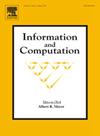正则语言的单调性表征
IF 1
4区 计算机科学
Q3 COMPUTER SCIENCE, THEORY & METHODS
引用次数: 0
摘要
每种语言L≥1≥1,推导出一个无限序列{Pr(L,n)}n=1∞,其中对于所有n≥1,值Pr(L,n)∈[0,1]为长度为n的单词在L中出现的概率,假设在Σ中的字母均匀分布。先前关于正则语言L的{Pr(L,n)}n=1∞的研究涉及到0 - 1定律、密度和积累点。我们研究了{Pr(L,n)}n=1∞,可能在极限下的单调性。我们证明了单调性可能取决于字母的分布,研究了语言上的操作如何影响单调性,并描述了序列是单调的语言的类别。我们将研究扩展到无限词的语言L,我们研究套索形词在L中的概率,并考虑Pr(L,n)的两种定义。第一个定义是指长度为n的前缀被扩展到L中的单词的概率,第二个定义是指长度为n的单词w使wω出现在L中的概率。因此,在第二个定义中,单调性不仅取决于w的长度,还取决于单词的周期性。我们还研究了各种定义下计算Pr(L,n)的复杂性。本文章由计算机程序翻译,如有差异,请以英文原文为准。
Monotonicity characterizations of regular languages
Each language induces an infinite sequence , where for all , the value is the probability of a word of length n to be in L, assuming a uniform distribution on the letters in Σ. Previous studies of for a regular language L, concerned zero-one laws, density, and accumulation points. We study monotonicity of , possibly in the limit. We show that monotonicity may depend on the distribution of letters, study how operations on languages affect monotonicity, and characterize classes of languages for which the sequence is monotonic. We extend the study to languages L of infinite words, where we study the probability of lasso-shaped words to be in L and consider two definitions for . The first refers to the probability of prefixes of length n to be extended to words in L, and the second to the probability of word w of length n to be such that is in L. Thus, in the second definition, monotonicity depends not only on the length of w, but also on the words being periodic. We also study the complexity of calculating for the various definitions.
求助全文
通过发布文献求助,成功后即可免费获取论文全文。
去求助
来源期刊

Information and Computation
工程技术-计算机:理论方法
CiteScore
2.30
自引率
0.00%
发文量
119
审稿时长
140 days
期刊介绍:
Information and Computation welcomes original papers in all areas of theoretical computer science and computational applications of information theory. Survey articles of exceptional quality will also be considered. Particularly welcome are papers contributing new results in active theoretical areas such as
-Biological computation and computational biology-
Computational complexity-
Computer theorem-proving-
Concurrency and distributed process theory-
Cryptographic theory-
Data base theory-
Decision problems in logic-
Design and analysis of algorithms-
Discrete optimization and mathematical programming-
Inductive inference and learning theory-
Logic & constraint programming-
Program verification & model checking-
Probabilistic & Quantum computation-
Semantics of programming languages-
Symbolic computation, lambda calculus, and rewriting systems-
Types and typechecking
 求助内容:
求助内容: 应助结果提醒方式:
应助结果提醒方式:


